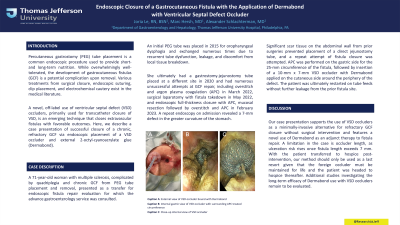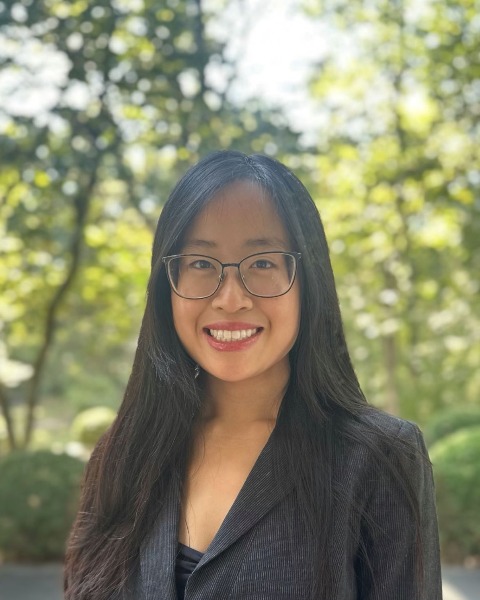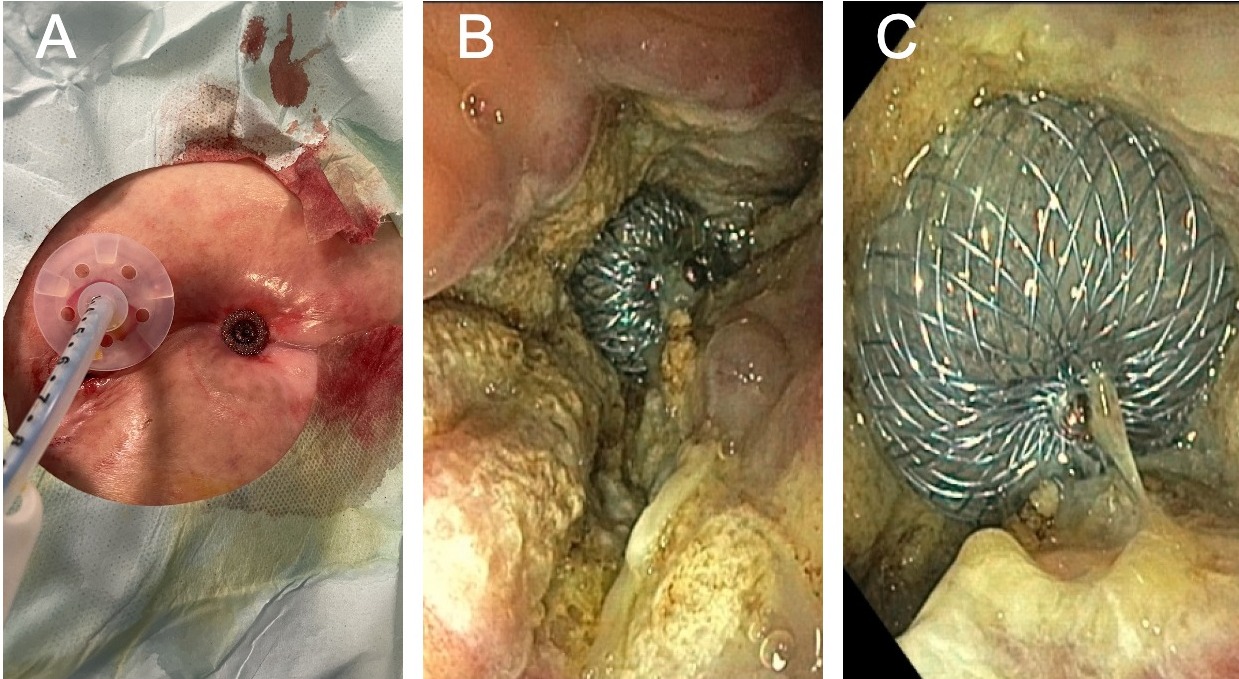Tuesday Poster Session
Category: Interventional Endoscopy
P3750 - Endoscopic Closure of a Gastrocutaneous Fistula With the Application of Dermabond With Ventricular Septal Defect Occluder
Tuesday, October 24, 2023
10:30 AM - 4:00 PM PT
Location: Exhibit Hall

Has Audio

Joria Le, RN, BSN
Thomas Jefferson University Hospital
Philadelphia, PA
Presenting Author(s)
Award: Presidential Poster Award
Joria Le, RN, BSN, Alexander Schlachterman, MD, Marc Hersh, MD
Thomas Jefferson University Hospital, Philadelphia, PA
Introduction: Percutaneous gastrostomy (PEG) tube placement is a common endoscopic procedure used to provide short and long-term nutrition. While well-tolerated, the development of gastrocutaneous fistulas (GCF) is a potential complication upon removal. Various treatments from surgical to endoscopic closure exist in the medical literature. A novel, off-label use of ventricular septal defect (VSD) occluders is an emerging technique that closes extravascular fistulas with favorable outcomes. We describe a case presentation of successful closure of a chronic, refractory GCF via endoscopic placement of a VSD occluder and external 2-octyl-cyanoacrylate glue (Dermabond).
Case Description/Methods: A 71-year-old woman with multiple sclerosis, complicated by quadriplegia and chronic GCF from PEG tube placement and removal, presented as a transfer for endoscopic fistula repair evaluation. An initial PEG tube was placed in 2015 for oropharyngeal dysphagia and exchanged numerous times due to recurrent tube dysfunction, leakage, and discomfort from local tissue breakdown. She ultimately had a gastrostomy-jejunostomy tube placed at a different site in 2020 and had several unsuccessful GCF repairs, including overstitch and argon plasma coagulation (APC) in March 2022, surgical laparotomy with fistula takedown in May 2022, and endoscopic mucosal resection followed by overstitch and APC in February 2023. A repeat endoscopy on admission revealed a 7-mm defect in the greater curvature of the stomach. Another GCF closure was attempted with APC performed on the gastric side for a 25-mm circumference of the fistula followed by insertion of a 10-mm x 7-mm VSD occluder with Dermabond applied on the cutaneous side around the defect periphery. The patient was then restarted on tube feeds without further leakage from the site.
Discussion: Our case presentation supports the use of VSD occluders as a minimally-invasive alternative for refractory GCF closure without surgical intervention and features a novel use of Dermabond as an adjunct therapy to fistula repair. A limitation in the case is occluder length, as ulceration risk rises once fistula length exceeds 7 mm. With the patient transferred to hospice post-intervention, our method should only be reserved for refractory cases as the foreign occluder must be maintained for life. Additional studies investigating the long-term efficacy of Dermabond use with VSD occluders remain to be evaluated.

Disclosures:
Joria Le, RN, BSN, Alexander Schlachterman, MD, Marc Hersh, MD. P3750 - Endoscopic Closure of a Gastrocutaneous Fistula With the Application of Dermabond With Ventricular Septal Defect Occluder, ACG 2023 Annual Scientific Meeting Abstracts. Vancouver, BC, Canada: American College of Gastroenterology.
Joria Le, RN, BSN, Alexander Schlachterman, MD, Marc Hersh, MD
Thomas Jefferson University Hospital, Philadelphia, PA
Introduction: Percutaneous gastrostomy (PEG) tube placement is a common endoscopic procedure used to provide short and long-term nutrition. While well-tolerated, the development of gastrocutaneous fistulas (GCF) is a potential complication upon removal. Various treatments from surgical to endoscopic closure exist in the medical literature. A novel, off-label use of ventricular septal defect (VSD) occluders is an emerging technique that closes extravascular fistulas with favorable outcomes. We describe a case presentation of successful closure of a chronic, refractory GCF via endoscopic placement of a VSD occluder and external 2-octyl-cyanoacrylate glue (Dermabond).
Case Description/Methods: A 71-year-old woman with multiple sclerosis, complicated by quadriplegia and chronic GCF from PEG tube placement and removal, presented as a transfer for endoscopic fistula repair evaluation. An initial PEG tube was placed in 2015 for oropharyngeal dysphagia and exchanged numerous times due to recurrent tube dysfunction, leakage, and discomfort from local tissue breakdown. She ultimately had a gastrostomy-jejunostomy tube placed at a different site in 2020 and had several unsuccessful GCF repairs, including overstitch and argon plasma coagulation (APC) in March 2022, surgical laparotomy with fistula takedown in May 2022, and endoscopic mucosal resection followed by overstitch and APC in February 2023. A repeat endoscopy on admission revealed a 7-mm defect in the greater curvature of the stomach. Another GCF closure was attempted with APC performed on the gastric side for a 25-mm circumference of the fistula followed by insertion of a 10-mm x 7-mm VSD occluder with Dermabond applied on the cutaneous side around the defect periphery. The patient was then restarted on tube feeds without further leakage from the site.
Discussion: Our case presentation supports the use of VSD occluders as a minimally-invasive alternative for refractory GCF closure without surgical intervention and features a novel use of Dermabond as an adjunct therapy to fistula repair. A limitation in the case is occluder length, as ulceration risk rises once fistula length exceeds 7 mm. With the patient transferred to hospice post-intervention, our method should only be reserved for refractory cases as the foreign occluder must be maintained for life. Additional studies investigating the long-term efficacy of Dermabond use with VSD occluders remain to be evaluated.

Figure: Caption A: External view of VSD occluder bound with Dermabond
Caption B: Internal view of VSD occluder with surrounding APC treated circumference
Caption C: Close-up internal view of VSD occluder
Caption B: Internal view of VSD occluder with surrounding APC treated circumference
Caption C: Close-up internal view of VSD occluder
Disclosures:
Joria Le indicated no relevant financial relationships.
Alexander Schlachterman: FujiFilm – Consultant. GI Supply – Consultant. Lumendi – Consultant. Olympus – Consultant.
Marc Hersh indicated no relevant financial relationships.
Joria Le, RN, BSN, Alexander Schlachterman, MD, Marc Hersh, MD. P3750 - Endoscopic Closure of a Gastrocutaneous Fistula With the Application of Dermabond With Ventricular Septal Defect Occluder, ACG 2023 Annual Scientific Meeting Abstracts. Vancouver, BC, Canada: American College of Gastroenterology.

